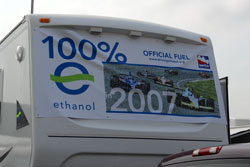 Bobby Rahal is very happy with his Team Ethanol car and driver Jeff Simmons this weekend (so far). That’s what he told me in an interview just a few minutes ago.
Bobby Rahal is very happy with his Team Ethanol car and driver Jeff Simmons this weekend (so far). That’s what he told me in an interview just a few minutes ago.
I was hoping to be able to interview one of the owners of Rahal-Letterman Racing and got my opportunity by the garages. Bobby says that he’s happy with the performance of the ethanol blend of fuel that’s being used this year in all Indy cars. He joked that he wishes he was the only one who could be using it.
Like most people who are involved in the ethanol industry he’s a believer in what using ethanol means to the environment and in reducing our dependence on foreign oil. He’s happy that the Indy Racing League has had the opporunity to be the showcase for how well ethanol works as a performance fuel.
You can listen to my interview with the Bobby here:  Bobby Rahal Interview (4 min MP3)
Bobby Rahal Interview (4 min MP3)
 The story this morning here at Chicagoland Speedway is the weather.
The story this morning here at Chicagoland Speedway is the weather. 



 One of the people who spoke at the 2007 Ethanol Ceremony was the Vice President of the Indy Racing League, John Lewis.
One of the people who spoke at the 2007 Ethanol Ceremony was the Vice President of the Indy Racing League, John Lewis. In a forward-looking ceremony this evening the Indy Racing League and Team Ethanol held a ribbon cutting ceremony to re-emphasize the League’s decision to move to 100 percent ethanol as its fuel source in 2007.
In a forward-looking ceremony this evening the Indy Racing League and Team Ethanol held a ribbon cutting ceremony to re-emphasize the League’s decision to move to 100 percent ethanol as its fuel source in 2007. Bobby Rahal is very happy with his Team Ethanol car and driver Jeff Simmons this weekend (so far). That’s what he told me in an interview just a few minutes ago.
Bobby Rahal is very happy with his Team Ethanol car and driver Jeff Simmons this weekend (so far). That’s what he told me in an interview just a few minutes ago. I think we’ll be seeing a lot of this over the next year as the Indy Racing League moves to 100 percent ethanol fuel.
I think we’ll be seeing a lot of this over the next year as the Indy Racing League moves to 100 percent ethanol fuel. They say they’re Jeff Simmons biggest fans. They’re Liz and John Fry.
They say they’re Jeff Simmons biggest fans. They’re Liz and John Fry. Speaking of EPIC members and fans.
Speaking of EPIC members and fans. The Ethanol Promotion and Information Council has a number of members on hand here for Chicago racing weekend. This morning they were checking people in before heading out to the track.
The Ethanol Promotion and Information Council has a number of members on hand here for Chicago racing weekend. This morning they were checking people in before heading out to the track. Jeff had an awesome practice session today.
Jeff had an awesome practice session today.